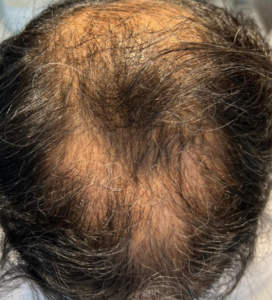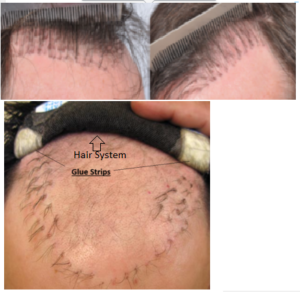This patient is 4 months out of his hair transplant. The shock loss he experienced in the Donor area has not reversed yet, although it is likely it will be by the 6th – 7th month. Patience here is a virtue. The doctor has a good reputation, which is important in knowing that this is not over-harvesting. I have seen shock loss in both the donor area (rare) and a few times in the recipient area with previously done hair transplants. These have all reversed within the same 7th – 7th month time frame. Fortunately, these are rare occurrences. CLICK ON THE PHOTO TO ENLARGE
According to the viceo script (https://www.instagram.com/reel/DHHaBNrSK5_/?igsh=NTc4MTIwNjQ2YQ====), girls reveal their hair length for the first time when they marry. One picture (far left) shows a woman with hair length of 3 meters, as she stands on a box to show the length. This means that this woman’s anagen cycle (continuous growth cycle) must last 4.6 years, assuming the hair grows at a rate of 1/2 inch per month. I wrote about this place in China in December 2017 (https://baldingblog.com/wp-admin/post.php?post=22588&action=edit).
Click on Photo to Enlarge
Why did my hair fall out when I started finastride?
Some people taking finasteride may lose hair when starting the drug. That means that the drug is forcing some hairs to switch where they are in their hair cycle and the drug is working. Hairs that fall out, will then go into anagen, and commence a new hair cycle with DHT being mostly blocked.
https://ecerm.org/upload/pdf/cerm-2024-07675.pdf
Conclusion: Long-term use of dutasteride may lead to male infertility by persistently impairing semen volume and sperm motility.
If someone took finastride their whole life and stopped at 80 would they go right to where they would have been if they never were on fin at all?
This hypothetical question is not straight forward. First, assuming that this 80 year old man had unherited a Class 7 pattern of balding and that finasteride was 100% effective at stopping hair loss. With this assumption, I am sure that he would revert back to his inherited pattern within a few months.
Although blocking DHT almost completely, is, theouitically, able to prevent hair loss for a very long time, there is also a genetic component in which the number of hair cycles of hairs within the balding pattern distribution is also subject to limitations. For example, if a specific young man is genetically going to develop a Class 3 pattern of balding, then if it he gentically programmed for 7 hair cycles of three years each on the life of these hairs, and these hair then die at the end of the 7 hair cycles (all at the exact same time for the purpose of this model), dutasateride can only prolong the hair cycles, not the number of hair cycles. So a simple math formulae would predict 7 hair cycles of 3 years each developing a Class 3 pattern of balding would appear immediately at 21 years of age (3 times 7). IF the cycles were prolonged to 4 years because of the drug (theoritically you start dutasteride when you are born for this calculation to work), then 7 cycles multipled by 4 years each, get you to an age of 28 before you develop that Class 3 pattern, all at once for this model. One morning you wake up, and in the shower your hair falls out and you develop an instant Class 3 pattern because your vulnerable hairs are at their life. those hairs within the Class 3 pattern. Of course, the hair cycle length varies by age and sex thoughout the formative years and within the pattern of balding, the hairs vary with their life expectancy. So simple calculations like those above make no sense, but it does show the complexity of making sense out of predicing hair loss with drugs like finasteride and/or dutasteride.
I hope that you had fun reading this.
I would like to know how to properly do this. Because I don’t know how lightly I should go or how long I should focus on/stab one area…I always seen to over do it slighly and make my scalp red have to stop after 2 or 3 days because of the sensitivity & flaking.
So how exactly do you guys that do it daily do it?
The point of microneeding is to create a wound adjacent to stem cells located between 0.75-2mm below the scalp’s surface. This produces a healing cascade, starting with bleeding, infusion of platelets, macrophages, and cytokines into the wound, and then stem cell activation. This stem cell activation produces a variety of stem cells. One group, in particular, controls hair cycling, and these stem cells are believed to cause hair growth cycling. That is why the depth of the needles and the repeated injury with a Dr. Pen device produce a controlled injury. I tell everyone to hold the device against the scalp for 10 seconds in each area. If there is too much pain, purchase a numbing medication from your local drug store and then apply it 30 minutes before the Dr. Pen is used. As I described above, Derma stamping and Dermarollers don’t produce a controlled wound. Adding minoxidil is beneficial, but the controlled wound gets you the results. Look at the posts on badlingblog.com earlier this week, and throughout Baldingblog.com for more examples of miconeedling results.
https://www.reddit.com/r/tressless/comments/1jl5w70/oculotoxicity_and_finasteride/
This is the first time I heard of any occullar problems from finasteride. I consistently report publications as I find them, and often, Reddit users perform considerable research on such issues, and they expand my daily studies (https://iovs.arvojournals.org/article.aspx?articleid=2690754).
Oculotoxicity and finasteride.
byu/HoldPrestigious1372 intressless
This is a comprehensive article written by Dr. Kavish Chouhan, a brilliant surgeon in Delhi, India whose intellectual curiosity I have always admired. The article reviews the many approaches to getting GREAT GRAFTS out with various FUE technologies.
I have seen this too often, that doctors do not give proper instructions for keeping the recepient area crust free. This worked at getting the crusts off and clearly pulled hair out. If the hairs he pulled out were done prior to day 9, he might have lost hair grafts forever. Shame on the doctor who did not foresee this in advance with proper instructions.
This is what surgeons did. Four decades of hair transplants, each session filling in the holes between the grafts. It often never happened as most men stopped at varying stages of this process, leaving them with Corn Rows of hair grafts. They would have to get two wigs, one for washing (as they often had a strong odor to them from sweat at the glueing point) and one to wash and dry. The men below had only a single session of plugs when they came to me for repairs. I performed thousands of repairs on men with this type of work and employed doctors to work with me. My office had 4 surgical rooms.
As shown in the second photo, most men went to hair systems (wigs) rather than show off their hair transplant surgery. This man shaved his head and wore a hair system glued to his scalp. Unfortunately, multiple sessions like this were the Standard of Care from 1959 into the 1990s. The concept was simply to do many sessions like this until you could not see the PLUGS. Unfortunately, they never got to look normal, regardless of how many hair transplant surgeries they received. Some men has as many as a dozen surgeries before they gave up.
I had asked myself why men would submit to such a barbaric surgery. The answer was (a) they wanted hair desperately and often came to the doctor with just thinning hair so the plugs were buried in their thinning and made them look better until they became bald when the hair around the plugs disappeared (almost 100% of the time), (b) the doctors employed salesmen who used pressure tactics, played off of the patient’s fear of going bald, and never really showed them the results they can expect, (c) it was the Standard of Care at the time and every doctor offering it, did it. It was shown in textbooks and taught in dermatology teaching programs, so the doctors who did this didn’t know better.
I had personal feelings of anger, as the doctor had denied these results as they made a good living, harming many men. When I entered this business in 1991, a famous doctor told me: “You will make a lot of money, like I have, just don’t make waves“. Of course, I never followed his advice and started my surgical practice doing large sessions of small follicular units on the very first surgery I performed. If the plugs were too close to the hairline, I would remove them, but if they were far back from the hairline, I would simply transplant hair around them and overwhelm the plugs in the forest of hair I would create. My work was loved by patients and hated by many of my colleagues. I published my work in peer-reviewed journals immediately. In 1994, I brought 23 patients (on my nickel) to the ISHRS hair meeting in Las Vegas. I brought the patients on the stage as I gave my lecture showing their before and after pictures, believing that if a picture was worth 1000 words, then the patients themselves were worth 10,000 words. After my lecture, the meeting was halted, and the audience of some 400 doctors walked across the stage (like a wedding reception) and looked closely at the patients. At that meeting, the debate with the “Old Guard” on the merits of what I was doing ended in 1994. What I was doing became the Standard of Care. It took about 6 years for most doctors to either quit or adapt. Change doesn’t come quickly for an industry the size of the hair transplants industry in the years before I entered the field. But change came, and men and women, across the world benefited.
Page 1 of 641












